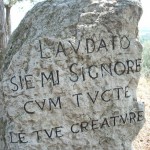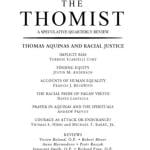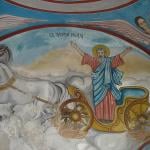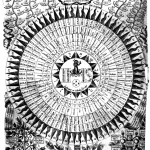I believe in doing what I can
Crying when I must, laughing when I choose
Hi, ho, if love were all
I would be lonely . . .
~ Noel Coward, “If Love Were All”
Happy (Demoted) Feast of (One of Several Possible) St Valentine(s)!
Today Americans take a break from vilifying the medieval anti-love Catholic Church to celebrate love with a medieval Catholic custom. The saint for whom this day and the mushy cards, candy hearts, and chocolate diamond necklaces so central to it is named is lost in the mists of obscurity. There were a number of men named Valentinus (from the Latin word for courageous–itself rooted in the word for heart) listed in the Church’s early martyrologies, but we don’t really know anything about them, other than that this date was assigned to commemorate at least one martyred Valentine. The feast itself was removed from the Roman calendar in the 1960s, along with those of other popular saints (Christopher, Philomena, Barbara) for whom the historical record is sparse or confused.
The association of this day with love is actually of medieval origin, when Valentine’s Day was literally for the birds. Popular custom marked this as the day when birds chose their mates (not a bad guess, from the increase in the pre-dawn chirping of baby birds the northern hemisphere will experience in a few weeks). Geoffrey Chaucer wrote “The Parliament of Fowls,” a long poem about the romantic cavorting of the gods on St Valentine’s Day, and that dragged the little winged boy with the arrows into it. Chaucer’s inspiration was his own inability to deal with the mystery of love, as he admits in his prologue:
The life so brief, the art so long in the learning, the attempt so hard, the conquest so sharp, the fearful joy that ever slips away so quickly–by all this I mean love, which so sorely astounds my feeling with its wondrous operation, that when I think upon it I scarce know whether I wake or sleep. For albeit I know not love myself.
With Chaucer’s avian prompting, February 14 became the day when lovers of all species chose their true loves. Shakespeare has Theseus, encountering the bewitched lovers of A Midsummer Night’s Dream asleep in a heap on the ground, make a chiding reference to this custom:
Good morrow, friends! St Valentine is past;
Begin these wood-birds but to couple now?
Reading back into legend, medieval Catholics assigned St Valentine the patronage of lovers. An invented hagiography makes him a bishop imprisoned for defying the law by marrying Christians. Because the whole quagmire of the Church’s teaching about marriage and who and what it’s for is still a place I can’t go without much more prayer and fasting than my life allows for now, I will just nod gently in the general direction of that irony: The Church used to be in the business of marrying people the law said weren’t marriageable. Huh. (Probably the Roman empire thought allowing monogamous lifelong Christian marriage between two people who loved each other would be an insult to the proper Kardashian-length, free, open, loose, cynical unions favored in society. Oh, wait . . .)
Poor Valentine, whoever he was, lost his head for love (that’s his flower-crowned skull in the reliquary shown at the top of this post), and now we’re supposed to do the same every year. This makes it very hard on those of us who never quite got the hang of it. We Charlie and Charlene Browns, whose doily-covered shoeboxes remained empty on our desks on this day. We Noel Cowards, poet laureates of the wry and witty lonelyhearts. We Elphabas, who know the wisdom of not wishing, because we’re not and will never be That Girl.
I’m not whining. I’ve loved and been loved far more than I deserved to in my life, and I’ve come to terms with the fact that, as far as relationships go, it’s my vocation to be the transitional object–to help people move on from disastrous relationships to soulmates, without ever being either. I’m the baton passer in this relay, and I’m just thankful I keep it moving in the right direction. It’s nice work if you can get it, but it’s not the stuff of which Valentines are made.
Which is why this day made it so easy for me to be a Gnostic for a while. There’s a Gnostic Valentine, too, one with a much better-documented history than the marrying bishop, even if the documenting was mostly done by his enemies. Valentinus was the Gnostic Christian bishop–a runner-up for pope, even–who formulated the best-known worldview of those who rejected this world as the delusional playground of a demiurge, a false creator. Christ, the Logos (Word) of God, came into the world to enlighten people. According to Valentinian Gnosticism, much influenced by Plato, what we experience of life and truth and love in this world are but false and distorted shadows of the reality knowable only by a few–the bliss of mystical union with the God beyond all knowing, which Valentinus called the sacrament of the Bride-Chamber. No valentines here? No problem. Transcend this tinseltown and you’ll experience real ecstasy. Gnosticism, like monastic life and standup comedy, is a big draw for those who are disappointed in love.
Now that I’m back in the fold, I can see that there’s a deep strain of Valentinian thought running through the writings of the more orthodox Christian mystics as well. The tradition of using the language of human love to attempt to capture the unspeakable joys of God’s love can be found in Francis of Assisi, Julian of Norwich, Teresa of Avila (Bernini makes her mystical ecstasy an X-rated valentine, with that Cupid of an angel and his golden arrow), John of the Cross, Therese of Lisieux–and indeed, goes back to the Song of Songs in the Hebrew Bible. That’s because it’s true that The Greatest Love of All is not any of our Valentines, be they lifelong partners or quick baton-passers, and why the best of this world’s Valentine’s Day gifts will fade. We are meant for the One who is Love, and if we are lucky the loving we do here will prepare us and those we love to bear the bliss of that Bride-Chamber, the marriage made in heaven for each of us.
With that in mind, I leave you with a Gnostic-tinged valentine from my favorite poet, and wish you a love that’s not Time’s fool, borne out to and beyond the edge of doom.
Let me not to the marriage of true minds
Admit impediments. Love is not love
Which alters when it alteration finds,
Or bends with the remover to remove:
O no! it is an ever-fixed mark
That looks on tempests and is never shaken;
It is the star to every wandering bark,
Whose worth’s unknown, although his height be taken.
Love’s not Time’s fool, though rosy lips and cheeks
Within his bending sickle’s compass come:
Love alters not with his brief hours and weeks,
But bears it out even to the edge of doom.
If this be error and upon me proved,











